Demystifying Bulgogi A Breakdown of the Main Ingredients
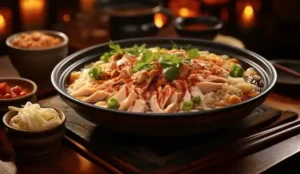
You’ve probably had bulgogi at your favorite Korean restaurant and wondered how they make that tasty, juicy, savory, marinated beef. Well, wonder no more! The magic of bulgogi lies in just a few key ingredients that come together to create a mouthwatering Korean grilled beef dish. In this article, we’ll break down the main components that give bulgogi its signature sweet, salty, smoky flavor and irresistible tender texture. You’ll learn each ingredient’s purpose, from soy sauce and sugar to garlic and sesame, so you can easily recreate this Korean barbecue classic at home. With this bulgogi recipe breakdown, you’ll be able to marinate your succulent beef in no time. So get ready to demystify this flavorful dish into something you can make any time your bulgogi craving strikes.
Demystifying Bulgogi A Breakdown of the Main Ingredients
What Is Bulgogi? A Quick Introduction
Rohani News:- Bulgogi, literally meaning “fire meat,” is a popular Korean barbecued dish of thin slices of marinated beef grilled on a barbecue or griddle. The beef is usually sirloin or rib eye, cut into bite-sized pieces.
Marinade
The key to bulgogi is the marinade, made of a mixture of sweet and savory ingredients like soy sauce, sesame oil, garlic, and sugar that gives the beef its distinctive flavor. The meat is usually marinated for at least 30 minutes to allow the flavors to soak in before cooking.
Demystifying Bulgogi A Breakdown of the Main Ingredients
Grilling
After marinating, the beef is grilled on a barbecue or griddle, often with mushrooms, scallions, or bell peppers. The constant turning and flipping of the meat results in a caramelized and slightly charred exterior while the inside remains juicy.
Bulgogi is usually eaten wrapped in lettuce leaves with a variety of side dishes like kimchi, pickled radish, and rice. The combination of the savory-sweet beef balanced with the fresh lettuce and spicy kimchi is what makes bulgogi such an iconic dish. Now you know why bulgogi has become popular all over the world.
Demystifying Bulgogi A Breakdown of the Main Ingredients
The Main Ingredients in Authentic Bulgogi
To make classic beef bulgogi at home, you’ll need just a few key ingredients. The star of the show is thinly sliced ribeye or sirloin steak. Flank steak and chuck also work great. ###
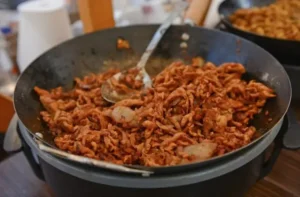
The marinade is essential for flavor and tenderness. A mixture of soy sauce, sesame oil, garlic, and sugar is typical. The sugar helps the meat caramelize as it cooks. Gochugaru, or Korean chili pepper flakes, add a little kick.
Onions and scallions provide flavor and aroma. Thinly slice and grill them with the beef.
Mushrooms like cremini or shiitake are optional but absorb the marinade and grill up nicely.
Don’t forget a fresh sesame seed garnish and lettuce leaves for wrapping it all up.
With just a few basic ingredients, you can make an authentic, delicious bulgogi meal at home. Fire up the grill or skillet, and get ready for a flavor explosion! The irresistible aroma and amazing taste will transport you to the streets of Seoul.
Demystifying Bulgogi A Breakdown of the Main Ingredients
Marinating the Bulgogi Meat: Tips and Tricks
To make bulgogi meat that’s bursting with flavor, marinating the beef is key. Here are some tips to make the most of the marinating process:
Choose a high-quality beef cut.
Flank steak, ribeye, or sirloin work great for bulgogi. Their dense, meaty texture holds up well to marinating and high-heat cooking.
Demystifying Bulgogi A Breakdown of the Main Ingredients
Score the meat.
Use a knife to lightly score the surface of the meat. This allows the marinade to penetrate deeper into the meat. Be careful not to cut through the meat.
Combine acidic and flavorful ingredients.
A mixture of soy sauce, sugar, garlic, scallions, sesame oil, and chili peppers creates a balanced marinade that’s sweet and savory with a kick of heat.
Demystifying Bulgogi A Breakdown of the Main Ingredients
Marinate for at least 4 hours or overnight.
To allow the flavors to fully develop, marinate the bulgogi in an airtight bag or container in the refrigerator. Turn the bag occasionally so the marinade coats all sides of the meat.
Discard the used marinade.
For safety, discard the used marinade after removing the meat. Do not reuse it.
Demystifying Bulgogi A Breakdown of the Main Ingredients
Pat the meat dry before cooking.
Remove the meat from the marinade and pat it dry with paper towels. This will allow for better browning and prevent the meat from steaming when you cook it.
Cook the meat in batches.
Cook the bulgogi in batches so you don’t crowd the pan. This allows for even cooking and browning. Serve and enjoy your flavorful bulgogi.
Demystifying Bulgogi A Breakdown of the Main Ingredients
How to Cook Bulgogi to Perfection
Cooking bulgogi is simple, but the key is not to overcook the meat. Once you have your ingredients prepped, you’re ready to cook.### Heat the pan
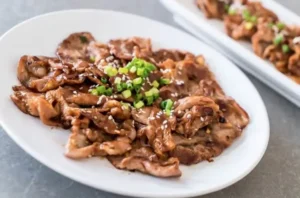
Heat a cast iron skillet or grill pan over medium-high heat. Add a bit of oil with a high smoke point like canola or grapeseed oil.### Add the meat
Add the marinated meat to the pan in a single layer. Cook without stirring for 3 to 4 minutes until the bottom is nicely browned.### Flip and cook
Demystifying Bulgogi A Breakdown of the Main Ingredients
Flip the pieces of meat and cook the other side until the meat is slightly pink in the center, about 2 to 3 minutes more.### Check for doneness
The total cooking time should be 5 to 7 minutes. To check if the meat is done, make a small cut in the thickest part of a piece of meat. It should still be slightly pink inside.
Demystifying Bulgogi A Breakdown of the Main Ingredients
Optional: Finish in the oven
If desired, you can finish cooking the bulgogi in a preheated 350 F oven. Spread the partially cooked meat on a foil-lined baking sheet and cook until the center is no longer pink about 5 more minutes. The oven will allow the meat to finish cooking evenly without over-browning.
Serve and enjoy!
Serve your bulgogi immediately with steamed rice, kimchi, lettuce leaves, and ssamjang sauce. The meat is best when hot, so dig in! Your perfect bulgogi is meant to be enjoyed with friends and family.
Demystifying Bulgogi A Breakdown of the Main Ingredients
Bulgogi Bowl Recipes: Creative Ways to Enjoy Bulgogi
Bulgogi is delicious on its own, but it also pairs well in creative bowls. Here are a few recipes to inspire you:
Bulgogi Beef Rice Bowl
A hearty bulgogi beef rice bowl is comforting and satisfying. Cook short-grain rice and top it with bulgogi beef, kimchi, sliced cucumbers, and a fried or soft-boiled egg. Garnish with sesame seeds and scallions. The kimchi provides spice while the egg adds protein. This bowl has the classic flavors of Korean cuisine.
Demystifying Bulgogi A Breakdown of the Main Ingredients
Bulgogi Lettuce Wraps
For a lighter option, fill lettuce leaves with bulgogi, rice, kimchi, and assorted veggies like carrots and bean sprouts. Wrap it all up in the lettuce and enjoy. The fresh, crisp lettuce contrasts nicely with the savory bulgogi. Kids will love assembling their wraps.
Demystifying Bulgogi A Breakdown of the Main Ingredients
Bulgogi Burrito Bowl
Fusion at its tastiest, a burrito bowl with bulgogi is a meeting of the culinary worlds. Fill your bowl with cilantro rice, black beans, salsa, guacamole, shredded cheese and bulgogi. Top with lime wedges, sour cream, and scallions. Hearty, protein-packed, and vibrant, this bowl blends Korean and Mexican flavors most deliciously.
Demystifying Bulgogi A Breakdown of the Main Ingredients
Ramen Noodle Soup with Bulgogi
For extra coziness, add bulgogi to a bowl of ramen soup. Use a rich tonkotsu or spicy kimchi ramen broth and add udon or ramen noodles, bulgogi, soft-boiled eggs, nori seaweed strips, scallions, and sesame seeds. The bulgogi enhances the savory broth and makes this dish even more satisfying. Comfort food at its finest.
Demystifying Bulgogi A Breakdown of the Main Ingredients
Demystifying Bulgogi: Understanding the Essential Ingredients in This Classic Korean Dish
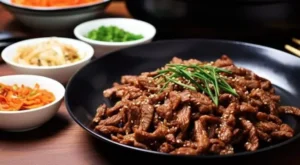
The Meat
To make authentic bulgogi, use thinly sliced ribeye or sirloin beef. Pork or chicken can also be used, but beef is traditional. The meat is usually sliced very thinly, about 1/4 inch thick, so it will cook quickly. For extra flavor, consider marinating the meat in a mixture of soy sauce, sesame oil, garlic, and sugar before cooking.
Demystifying Bulgogi A Breakdown of the Main Ingredients
Aromatics
The distinctive taste of bulgogi comes from a blend of aromatics like garlic, ginger, and scallions. Minced garlic and freshly grated ginger add a spicy kick, while scallions contribute a mild oniony flavor. Chili peppers are also commonly used, which provide a subtle heat and crimson color to the dish.
Sauce
A savory sauce made of soy sauce, sugar, sesame oil, and spices gives bulgogi its characteristic sweet and savory glaze. The sugar helps the meat caramelize as it cooks, creating a lovely browned crust. Sesame oil adds nutty, buttery undertones. Other common additions include rice wine or sherry, which provide a touch of acidity.
Demystifying Bulgogi A Breakdown of the Main Ingredients
Garnishes
Once cooked, bulgogi is usually garnished with toasted sesame seeds and sliced scallions, which provide texture, aroma, and freshness. Kimchi, pickled daikon radish, and lettuce leaves are also popular garnishes, as well as a variety of condiments like gochujang chili paste. Serve the bulgogi with steamed rice to soak up the delicious sauce.
Demystifying Bulgogi A Breakdown of the Main Ingredients
What Are the Ingredients in Bulgogi? A Guide to Making Korean BBQ Beef at Home
To make authentic bulgogi at home, you’ll need a few key ingredients. The star of the show is ribeye or sirloin beef, sliced very thinly. Meat like strip loin, chuck roll, or flank steak also works great. Look for beef that is well-marbled, which means it has lots of fat distributed throughout the muscle. This fat will melt as it cooks and keep your bulgogi juicy.
Demystifying Bulgogi A Breakdown of the Main Ingredients
For extra flavor, bulgogi usually contains a mixture of soy sauce, sugar, garlic, and sesame oil. The soy sauce adds a savory saltiness, while the sugar helps caramelize the meat. Minced garlic provides an aromatic kick, and sesame oil contributes a nutty richness. You can also add other ingredients like scallions, ginger, chili peppers, or rice wine to suit your tastes.
Demystifying Bulgogi A Breakdown of the Main Ingredients
Aside from the beef and marinade, you’ll need some basics to cook the bulgogi. Metal skewers or tongs are useful for turning the meat. You’ll also want a grill, grill pan, or skillet to cook the beef. Serve your bulgogi with lettuce leaves or perilla leaves to wrap the meat, along with kimchi, bean sprouts, and steamed rice.
Demystifying Bulgogi A Breakdown of the Main Ingredients
With these essential ingredients and a little patience while cooking, you’ll be enjoying delicious homemade bulgogi in no time! The key is not to overcook the beef, so it remains juicy and flavorful. Cook the meat in batches to avoid overcrowding the pan or grill. Keep an eye on your bulgogi and flip frequently for even cooking. In just a few minutes, your kitchen will be filled with the amazing aroma of sizzling garlic and sesame. Enjoy.
Demystifying Bulgogi A Breakdown of the Main Ingredients
What Goes Into Bulgogi? Unlocking the Flavors of Korea’s Famous Grilled Beef
The ingredients in bulgogi are simple, but combined create an explosion of flavors. The main components are thin slices of beef, usually ribeye, sirloin, or brisket. The beef is marinated in a mixture of sweet and savory ingredients like sugar, soy sauce, sesame oil, garlic, and scallions.
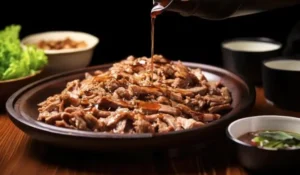
Gochugaru, Korean chili pepper flakes, provide a kick of heat and spice. Grated Asian pears or apples are added to naturally tenderize the meat. Honey or brown sugar balances out the flavors with a touch of sweetness. Minced garlic and scallions provide an aromatic, oniony flavor. Soy sauce adds a robust, umami-rich saltiness. A splash of sesame oil provides a nutty, buttery flavor.
Demystifying Bulgogi A Breakdown of the Main Ingredients
Optional extras include mushrooms, bell peppers, or kimchi for extra vegetables. Pine nuts or sesame seeds add a little crunch. Lettuce leaves are used to wrap the grilled beef. A side of steamed rice is perfect for sopping up the flavorful marinade.
With all these flavors mingling together, it’s no wonder bulgogi has become popular around the world. The balance of sweet and savory, spicy and tangy, creates an irresistible combination. Once you unlock the key ingredients, you’ll be making delicious bulgogi at home in no time.
Demystifying Bulgogi A Breakdown of the Main Ingredients
Easy Homemade Bulgogi Sauce Recipe Revealed
To make authentic homemade bulgogi sauce, you’ll need a few simple ingredients. The exact ratios can vary based on personal taste, but here’s a basic recipe to get you started:
Demystifying Bulgogi A Breakdown of the Main Ingredients
Combine 1/3 cup soy sauce or tamari, 2 tablespoons sugar (brown sugar or honey also works great), 2 minced garlic cloves, 1/2 teaspoon grated fresh ginger, and 2 teaspoons sesame oil. You can also add 1-2 tablespoons of rice wine or sherry and some crushed red pepper flakes for extra spice. Mix all ingredients thoroughly until the sugar and garlic have dissolved.
Demystifying Bulgogi A Breakdown of the Main Ingredients
Pour the sauce over 1-2 pounds of thinly sliced ribeye, sirloin, or flank steak. Let the meat marinate in the refrigerator for at least 30 minutes to absorb all the delicious flavors. Longer is even better, up to overnight. When ready to cook, heat a skillet (cast iron is ideal) over medium-high heat and cook the beef in batches until browned.
This homemade Korean BBQ-inspired bulgogi sauce hits all the right savory and sweet notes. The mixture of soy sauce, garlic, and sesame provides an authentic umami-rich flavor, while the sugar helps balance and caramelize the meat as it cooks. Your kitchen will smell amazing, and your taste buds will thank you! Adjust ingredients to your desired flavor and enjoy your bulgogi with rice, kimchi, and lettuce wraps.
Demystifying Bulgogi A Breakdown of the Main Ingredients
Conclusion
So there you have it – everything you need to know to make delicious bulgogi at home. With just a few simple ingredients like soy sauce, sesame oil, garlic, and ginger, you can whip up this iconic Korean dish and impress your family and friends. The key is getting high-quality, thinly sliced beef and marinating it properly so all those tasty flavors can permeate the meat. Grill it up nice and hot so you get a nice char but keep the inside tender and juicy. Serve it alongside steamed rice and some kimchi for the full experience. Now that the mystery has been taken out of Bulgogi, it’s time to fire up that grill and get cooking. This tasty dish is easier to make than you think, so give it a try tonight.
FAQs
Bulgogi, like any dish, comes with a lot of questions. Here are some of the most common ones:
How spicy is bulgogi?
Bulgogi can be as spicy or mild as you like. The spice level depends on the amount of gochujang (Korean chili pepper flakes) you add. Start with 1/2 teaspoon and add more to taste.
What cut of beef is best for bulgogi?
Thinly sliced ribeye or sirloin works well for bulgogi. Look for meat that is moderately marbled with fat for more flavor. Have the butcher slice the meat 1/4-inch thick.
Can I use a grill instead of a skillet?
Absolutely. Grilling the marinated beef over high, direct heat will give it a nice char and smoky flavor. Make sure to drain the excess marinade from the meat before grilling.
How long does bulgogi last?
Bulgogi will last up to 3 days refrigerated. Freeze bulgogi for up to 3 months; simply thaw in the refrigerator overnight and reheat before serving.
Can I substitute ingredients?
Brown sugar can replace the Asian pear. Soy sauce or tamari can be substituted for fish sauce. Rice wine or sherry can substitute for sake. Gochugaru is essential for heat and color, but cayenne pepper will work in a pinch.
What sides go well with bulgogi?
Bulgogi pairs perfectly with steamed rice, kimchi, bean sprouts, lettuce leaves, and ssamjang (Korean chili-soybean paste) for wrapping.
Can I make bulgogi in advance?
Yes, bulgogi can be made 1-2 days ahead. Marinate the beef, then drain and reserve the marinade. Refrigerate the beef and marinade separately. When ready to serve, reheat the beef in a skillet with a few tablespoons of the reserved marinade.

